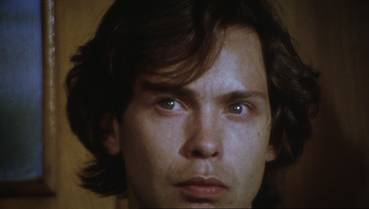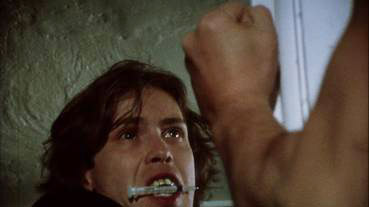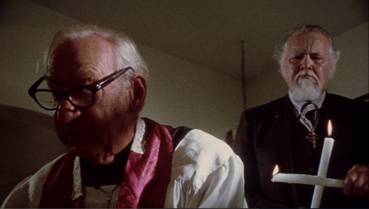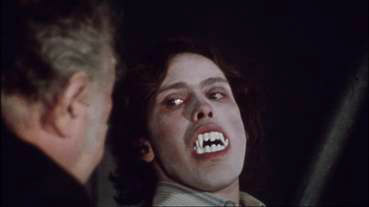"Things
only seem to be magic. There is no real magic. There's
no real magic ever." |
Martin
to cousin Cuda |
It is a little ironic – though at the same time perhaps typical of great
independent cinema – that one of the most intelligent and
revisionist vampire movies to date made may not be a vampire
movie at all. It's a question that has hovered over the
film ever since its release and is central to its narrative
– is Martin Madahas an 84-year-old vampire or a mixed-up
kid with psychotic tendencies? Either way, Martin
is a genuinely great vampire movie, one that recognises
and fully understands generic conventions and yet turns
most of them completely on their head.
If
you like to think of yourself a fan of horror cinema then you should already
know Martin well. Even if you only have
a part-time relationship with the genre then you should be aware
of the work of its director, George Romero (whose middle
initial, 'A' is as come-and-go as Francis Coppola's 'Ford').
Made shortly before he had what may be his most
influential success of all with Dawn of the Dead,
Martin was for some time Romero's most talked
about but least seen film, the perfect condition for the
birth of a cult whose steady growth has been matched
by an increased critical appreciation of the horror film
as a vehicle for social commentary.
Very
much a film of its changing times, Martin
was the first vampire movie to completely shake off the
genre's folklore origins and the shadow of novels that effectively
shaped the first 50 years of vampire cinema. It recognised
the shifting nature of both the horror audience and the
fears of the society in which it lives, a post-Charles
Manson, post-Ed Gein era in which you could be killed for
no reason by someone who lived on the same street as you. This
is an aspect acknowledged and sugnalled by the title. Like that most famopus of all vampire tales, Dracula,
the name of the
vampire is the name of the film, but whereas 'Dracula' invokes
a sense of the exotic, the mysterious and the foreign (appropriate
for a time in which international travel was the province
of the upper classes, and when everything foreign was regarded
either with wonder or deep suspicion), 'Martin' is deliberately
ordinary, an everyday name that has no specific connotations
other than its commonplace familiarity.

The
development of the vampire subgenre has seen the figure of the vampire shift steadily in locale and class, as it moves closer
to home and descends in social rank.
In Universal's Dracula
the vampire is as he was in Bram Stoker's novel, a nobleman from
far way lands, a figure of wealth and supernatural power with
three obedient wives at his disposal. By the time Hammer delivered their spirited 1958 adaptation, the vampire
was a Count in name only, living more as a local lord
in a monogamous (if abusive) relationship and only a brisk horse ride from the town he eventually lays siege to. But
Martin brought the vampire onto our doorstep
and stripped him of nobility, casting him as an ordinary teenager who lives in a spare room at his elderly cousin's house. He has
no bride, no girlfriend, and unlike the sexually potent
vampire of lore is actually afraid of women
and sex. Martin is the boy next door, a reclusive and uncommunicative
kid, the sort of loner that the CIA would probably peg as having terrorist
potential. He's that shy boy who, if stories are to be believed,
one day shocks the neighbourhood by doing something horrible
and wildly out of character that, just for a few moments, makes
him special. He is, of course, the product of his family
and environment – all his life he has been told he is bad
and now he believes it and acts accordingly, a self-fulfilling
prophecy if you will. Well that's one reading...
In
the film's notorious opening sequence, Romero confronts
us head-on with the unpleasant reality of what a non-supernatural
vampire killing actually entails, and in the process sets
Martin up as the film's monster. Not that you'd
realise it to look at him. Gawky, shy and seemingly intimidated
by everything around him, he's about as far from the traditional
figure of the all-powerful vampire of movies and literature
as you could imagine. But even as he boards the train on which
the film's first murder will take place, he is selecting
his victim. He may lack the supernatural power of Bela Lugosi's
Dracula or the animal strength of Christopher Lee's Count, but
he makes up for it in knowledge and experience – he knows
how to incapacitate his victim with drugs, how to pick
the lock of her sleeper compartment, and how to cover his
tracks when the deed is done. And it's a nasty and bloody
deed. His target is no willing victim seduced by his hypnotic
power and good looks, she fights him all the way, physically
and verbally until dragged into drug-induced unconsciousness.
Even as she fades, Martin assures her that she'll be all right.
She won't. Once she is out cold, Martin strips her and himself
bare, pulls her on top of him, slashes her wrist with a
razor and hungrily drinks her blood, then cleans himself
up and coldly arranges the room to suggest that her death
was the result of suicide. This is the vampire brought down to earth,
stripping it of all of the trappings that distance most movie
vampires from reality until all that is left is a calculating
serial killer.
In
one of the most memorable images in modern vampire cinema, Martin
is briefly framed at his victim's door with a syringe held
ready in his mouth (this will recur later), which can't help but read as a reworking of a key piece of traditional vampire iconography. Here the
needle replaces the fang – both are used to sedate and ultimately
destroy the vampire's prey, but while the familiar elongated
canine teeth link the vampre to the wolf or the vampire bat into which he is fabled to be able to transform, for most viewers the syringe has unpleasant real world associations. Its surgical
nature also directly reflects Martin's approach to his assaults,
which are planned and executed like black ops military stealth assassinations. Brilliantly
constructed and edited (the use of rapidly cut big close-ups
is particularly impressive), this is nonetheless a deliberately
confrontational and uncomfortable opening. How could any
audience sympathise with such a boy?

Enter
Tada Cuda. Immaculately dressed in white from head to toe
like a stern-faced Colonel Sanders, he is Martin's cousin,
a member of the boy's extended family and the latest one
to be charged with the task of watching over him.
He meets Martin's train and strides ahead of him
to catch the next one while the boy shuffles nervously behind. When
Cuda looks at Martin he crosses himself – he's never met
him before but has already made up his mind about him. Once
at Cuda's house, it's astonishing how quickly our
allegiance shifts, as Martin the monster becomes Martin
the put-upon, misunderstood, verbally bullied teenager and
Cuda assumes the role of overbearing and unloving parent.
He clings to the old beliefs, to the concept of the folklore
vampire, decorating his the house with Christian artifacts
and his own room with garlic and crosses as protection against
this young 'Nosferatu', generic iconography that Martin debunks
by kissing the cross and taking a bite from the garlic.
"It's not magic," he tells Cuda. The old man
is not so easily convinced. Then again, religiously obsessed
parental figures rarely are.
From
here on in Martin becomes the subject of increasing audience
sympathy, a representation of lost youth in a decaying town
populated by the intolerant old and couples whose relationships
have fallen into stagnation. It's a community almost devoid of life – even
the church is in disrepair after a fire, its pews improvised using canteen chairs
and an altar cobbled together from a broken television. The priest, on the other hand (wonderfully played by
Romero himself), is new to the parish, an easy-going symbol of changing times who is fond of his wine
and cigars and has trouble taking Cuda's old-style notions
of evil seriously.
Martin's
one ally is Cuda's twenty-something granddaughter Christina,* a fellow resident of the house whom Cuda has forbidden Martin
to speak to. She is an opposing force to Cuda in every respect
– young, defiant and progressive, and convinced that Martin
is the victim not of a vampire curse but of harmful family
superstition and prejudice. It is she who opens the lines
of communication to Martin, offering to share a phone line
with him in spite of Cuda's protestations regarding this Devil's
device. It's an offer Martin eventually accepts, then using the phone to call
in to a local talk show to put its host right on vampire mythology,
in the process becoming the show's most popular phone-in
guest. That Martin is able to communicate more lucidly through
an electronic device rather than face-to-face is not only
representative of the disconnected youth of the mid to late
70s (whose collective rejection of social values of the
time helped give birth to the Punk movement), but also anticipates today's
mobile phone generation, for whom texting and social media interraction sometimes seems preferable to direct conversation.

Our
engagement with Martin meets its greatest moral challenge
in the film's centrepiece scene, a night-time break-in that goes
wrong when he walks in on his victim – whom he has selected in part because her husband is away on business – and discovers her in flagrente delicto with
her lover. In the immaculately staged sequence that follows,
Martin's experience and level-headedness keeps him consistently
one step ahead of the couple's attempts to both track him
down and call for help, the house a dizzying maze of corridors,
stairs and doorways that Martin is able to use against people
who should know them better than him. We may have been shocked
by the opening sequence, but we actually find ourselves rooting
for Martin here, even though his purpose and the potential outcome
are the same.
Perhaps
the most telling relationship is the one that developes between Martin and Mrs. Santini, one of the customers to whom he makes
grocery deliveries for Cuda. A depressed housewife whose
relationship with her husband is no longer based on love
or desire (he is only seen once, when he gruffly pulls his wife
away while she is talking to Martin), her gentle
come-ons are at once both a cry for affection
and a lament for her own lost youth and wasted life.** In
a complete reversal of the genre norm, here the potential
victim attempts to seduce the vampire and he reacts initially
by running away. When he does return his approach is simultaneously
direct and awkward. "You want me here for sex, don't
you," he asks her. This is the only time he refers to
sex directly, on the radio phone-in alluding to it more
self-consciously as "the sexy stuff." As their
irregular liaisons continue, Martin's craving for blood
abates, subtextually casting his earlier murders in a masturbatory
rather than forcefully sexual light, the secret nocturnal
activities of a young boy that diminish once he gets his
first taste of the real thing. What this inexperienced adolescent
fails to realise is the nature and cause of Mrs. Santini's
emotional pain, something that will later have dramatic
and unexpected consequences for them both.
The
uncertainty over whether Martin really is an 84-year-old
vampire or a screwed-up kid with homicidal tendencies remains
tantalisingly unresolved, the intermittent black-and-white
inserts set in some undefined turn-of-the-century township
functioning either as memories or fantasies, depending on
your take on the story.*** Martin himself believes he is
84 years old but rejects Cuda's mystic take on his condition,
mocking his beliefs with a pantomime vampire costume and
using a simple off-the-shelf magic trick to point out that,
"there is no real magic." This rejection of the
supernatural includes Cuda's strongly held religious faith
and by association its standing within the genre – it's certainly ineffectual when it comes to Martin's condition, and is seen as irrelevant by a generation that has turned against the values of its elders and is looking
for more concrete answers of its own, ones not steeped in dogma and
superstition.

Martin
takes the codes and conventions of the vampire subgenre and
reworks them to genuinely revolutionary ends, with one eye on the past
but the other fixed firmly on the society in which the film
was made. In that respect, it has to be seen as the first
truly modern vampire film, a strikingly intelligent, inventive
and socially relevant take on a genre that even in the 70s
was still hanging onto the coat-tails of the Transylvanian
Count whose story gave it birth. Martin
contemporised the vampire tale, not by transporting Dracula
to swinging 70s London but by exploring modern fears
through modern eyes and confronting the audience, perhaps
for the first time, with what it really means to be so afflicted.
That it remains as fresh a work today is, a tad ironically, partly due to its lack of mainstream success.
When commercial cinema eventually re-embraced and re-thought the vampire
film in the 1980s, it had learned little from Romero's groundbreaking movie, with the younger protagonists of The Lost Boys
– dressed to look cool and pining for MTV – having more
to do with audience demographic than a desire to explore
the genuine fears of society or the traumas of youth. Martin thus remains unique
within the genre, a low-budget gem of astonishing depth and complexity
that showcases Romero's storytelling and filmmaking skills at their keenest (the editing alone is genuinely astonishing),
and built around an utterly convincing central performance
by the young John Amplas and a support cast of largely natural
non-professionals. There is simply no contest here – Martin
is THE modern vampire film. End of story.
OK,
let's get the aspect ratio issue out of the way first. Framed
16:9 and anamorphically enhanced, this is actually cropped
down from a 4:3 16mm original. Romero fans will probably be aware that
the director has stated his preference for that
original framing, and if you look at both versions side-by-side it's
easy to see why. Close-ups are rendered claustrophobically
uncomfortable and characters are cut in half in some of the wider
shots, while in one of Tom Savini's best make-up effects shots, the
effect itself is pushed completely off screen. Have a look at the comparisons
below with Anchor Bay's now sadly discontinued region 1
disc.
| |
|
|
|
|
|
| Arrow
Films UK disc (left) and Anchor Bay US disc (right) |
But
even allowing for that (and I don't see why I should), the
picture quality here still comes in a weak second best to
both the Anchor Bay disc and the New Line re-issue from
which this disc is sourced (which was also the wrong aspect
ratio, of course), suggesting NTSC to PAL transfer issues,
although there are is no motion blurring to back that up.
Sharpness is less impressive than on the Anchor Bay disc,
with grain far more prominent (the picture has been enlarged
to fill the widescreen frame, of course) and the colours less
natural-looking. The picture is also somewhat darker – or perhaps
I should say muddier – with detail in shadow areas particularly
poor. On the whole, a major disappointment.
There
are two soundtracks available, Dolby stereo 2.0 and 5.1
surround. Music aside, both are largely mono, with the sound
spread across the front speakers on the 2.0 track and confined
largely to the centre on the 5.1. The sound quality seems identical on both, clear with no noticeable problems.
This
new release from Arrow films is marketed as a 2-Disc Special
Edition and even comes in a cardboard sleeve to prove it.
However...well, more on that when we get to disc 2.
The
Anchor Bay disc only had one extra, but it was a damned
good one, a commentary by George Romero, Tom Savini and Martin
himself, actor John Amplas. It was an insightful and enjoyable
look back at the making of the film and became famous for
the discussion of a three-hour cut that was stolen and never
recovered, and even included a plea for its return, despite
the years that had past since its theft. For this Arrow release, a new commentary
was recorded featuring Romero and Savini, with John Amplas replaced by producer Richard Rubenstein, composer (and Richard's
brother) Donald Rubenstein, and cinematographer Michael
Gornick. Curiously, Savini's name is not listed with the
others on the extras menu. Fortunately, this proves as engaging
and informative as the commentary on the Anchor Bay disc,
and – thanks in part to the new participants – is different enough in content
to be of real value even to those who have the earlier DVD. The
five men are clearly old friends and there is a fair amount
of joking with each other that is pretty funny in places,
plus a nice selection of anecdotes amongst the technical
details (the technician left outside swinging a light when
everyone took a break, how much Stephen King hated Stabley Kubrick's film adaptations of The Shining, etc.). Romero also believes
that the house chase sequence that I so admire may be the best scene he's ever done, and in the joshing says "Forget
about it!" almost as much as Donnie Brasco. There's
also a brief but interesting reflection on post-9/11 hysteria
in America on which they all appear to be impressively united.
As
for disc 2, well... OK, this has been one of my pet peeves
for some time now, spreading a single DVD's worth of film
and extras over 2 discs to better justify the Special Edition
label, but this has to be a new record. If you were to lay
all of the extras here end to end you'd have precisely 12
minutes 3 seconds of video material, 1 minute 2 seconds
of audio and 17 small stills. Which is, quite frankly, taking
the piss.
Making
Martin: A Recounting (9:30) is an insubstantial
featurette in which a very few of those involved in the
making of the film look back at at a work Romero himself
regards as his finest. Of interest is a brief trip back
to some of the locations used, although we could have had
a lot more on this, and just about everything else as it
happens. Adding to the piss-take factor, this is in widescreen
but not anamorphically enhanced – it's not as if space here
was at a premium. Admittedly Arrow have licensed this from
the Lion's Gate disc, where it was all on one DVD, but still...
There
are 2 Radio Ads (0:26 and 0:56),
which are of interest, but more so when linked to the Theatrical
Trailer (2:33) which includes an address to
camera from Martin that is not in film and possibly shot
specifically as promotional material – it is his voice from
this shot that is used in the radio ads.
The
Stills and Poster Gallery consists
of 17 promotional stills and posters, three of which are
virtually identical. There is a lot more promotional artwork
out there that should have been included. They are also
way too small.
I
absolutely love this movie, I'm a lot less enthralled with this DVD.
I can't hold Arrow responsible for the aspect ratio issue,
as they appear to have licensed the whole product from Lion's
Gate, who must thus take the blame for the cropping of the picture. But
the picture quality is still shabby in comparison to the
Anchor Bay disc, and aside from the commentary, the extras
here are paltry for a Special Edition. But the commentary
IS good, and that may prove enough for hardened Romero fans
(it was for me), though if you have the Anchor Bay disc
then I'd suggest hanging on until the price drops a bit before shelling out for this one,
perhaps in the summer sales. If you haven't, then I'd get
searching, or hassle Anchor Bay for a re-issue. Frankly,
I'm going to put my copy somewhere very safe.
|